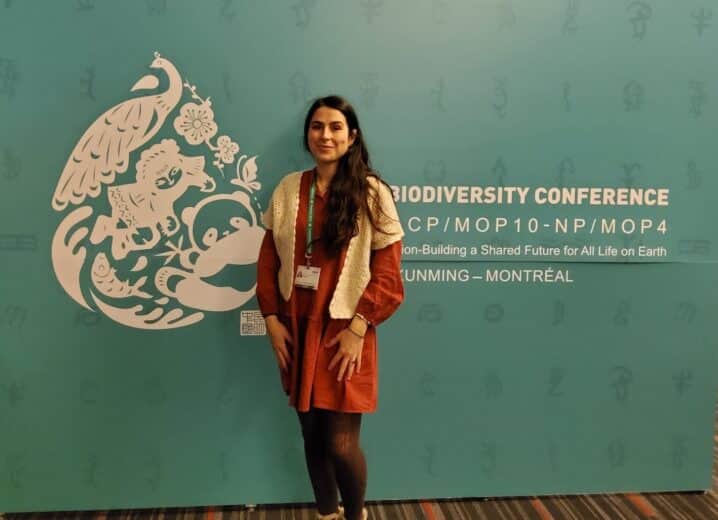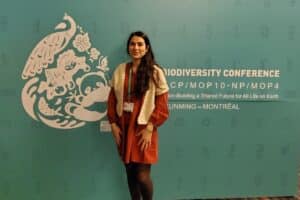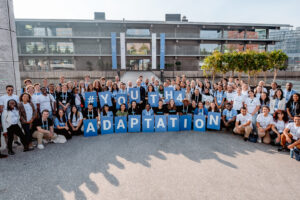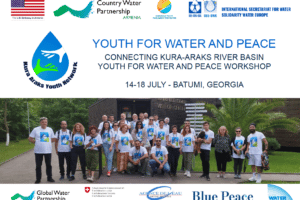Description
This is an opinion piece written by Noémie Plumier, member and Strategic Partnership co-Facilitator of the World Youth Parliament for Water.
—
I attended a COP for the first time in my advocate and activist life, as a member of the Global Youth Biodiversity Network, the Youth Constituency of the Convention on Biodiversity (CBD) in Montréal.
Canada hosted, with the People’s Republic of China as president, the most important biodiversity event of the decade : the 15th Conference of the Parties of the Convention on Biodiversity.
This COP was postponed multiple times due to the Covid pandemic.
All the States countries of the United Nations Convention on Biological Diversity, so-called “the Parties”, got together to negotiate the Post-2020 Global Biodiversity Framework or Kunming-Montreal Global Biodiversity Framework; what 23 targets and 4 goals are needed until 2030 to live in harmony with nature by 2050.
Antonio Guterres set the tone at the opening ceremony, stating that “humanity has become a weapon of mass extinction” painting out “our unchecked and unequal quest for growth”. According to the Intergovernmental Science-Policy Platform on Biodiversity and Ecosystem Services (aka IPBES), there are five direct drivers to biodiversity loss : changing use of sea and land, direct exploitation of organisms, climate change, pollution and invasive non-native species. Welcome to the Anthropocene era !
GYBN members started a silence protest campaign inside the COP called “no more brackets” (laying dead on the floor with brackets draw on cheeks) and a social media campaign called #stopthesame.
Before the beginning of the negotiations there were hundreds of thousands of brackets to clean (a jargon expression I heard) before the plenary final version submitted for adoption. What a waste of time …
Unlike the famous climate COP of the UNFCCC, COP of CBD are relatively open no matter which badge you wear. There are still some close meetings happening but you can be aware of the room it takes place in and join prior or after the meeting at the entrance, to reach the negotiators. It seems to be an inclusive atmosphere, the only event that was strictly on invitation only in-person was the High-Level Segment, but we could access it online.
As a youth representative, some members of the policy team were welcomed at most of the close negotiations in reduced numbers.
Target 22 is GYBN’s COP15 biggest lobbying success !
We succeed to add and keep the word youth : ” Ensure the full, equitable, inclusive, effective and gender-responsive representation and participation in decision-making, and access to justice and information related to biodiversity by indigenous peoples and local communities,respecting their cultures and their rights over lands, territories, resources, and traditional knowledge, as well as by women and girls, children and youth, and persons with disabilities and ensure the full protection of environmental human rights defenders.” (Source : https://www.cbd.int/article/cop15-final-text-kunming-montreal-gbf-221222 )
I participated in a public march for “all life” on Saturday afternoon from Mont Royal to UQAM at -10 degrees celsius. It was a moment of unity, mainly composed of civil society (NGOs, families and individuals) and surprisingly a lot of media coverage. The First Nations and indigenous peoples present were at the front of the procession.
During the march, I was dressed as a bird. BirdLife International lent me the costume. Birds are our early warning system about the health of ecosystems. I recommend that you read Silent Spring by Rachel Carson if you are interested.
I attended several side events, especially some focusing on water. I was surprised again by the siloed conversations between freshwater and saltwater/ocean communities or inland water, coastal and marine ecosystems differences made.
The water paradox of being everywhere and invisible at the same time was also something that struck me here, even though we are outside of the Sustainable Development Goals 6. How can we expect to find solutions to complex ecosystems in perils looking at them with narrow categories ? Everything is interconnected, and water is part of what connects it all.
The need of human-rights based approach (HRBA) or people-centered approach in the Post-2020 GBF was raised by panelists who were country representatives from LAC, they called upon the audience, mainly civil society, for more “noise and support” in the room and outside the room of negotiations.
In these HRBA conversations, the right to a clean, healthy and sustainable environment predominates; I never heard once of the right to water and sanitation being mentioned.
The link between biodiversity conservation and climate change mitigation was at the heart of a lot of interventions. As well as the undeniable importance of indigenous and local communities rights, knowledge, practices and management of biodiversity. (Cf: Target 21 for more details)
I attended a special close side event with States ministers (Germany, France, New Zealand, Costa Rica, Vanuatu, Chile, Palau and Spain) and civil society (SOA, Nature Conservancy, and individuals). I follow with high interest the discussions about deep seabed mining and its exploitation by private companies. As you may know, it is a critical topic ,we need minerals for renewable energy and digitalization but the consequences on the marine ecosystems could be catastrophic. Some states are in favor of a moratorium, because we all depend on the ocean for life on Earth. Some of us are concerned, taking into account what we were capable of on lands in plain sight, of what will happen deep down there. I encourage you to raise awareness and put pressure on your country representatives on that topic. It concerns us all. Tell them to take part in the decisions and negotiations at the International Seabed Authority. Even if you don’t have coastlines, one breath out of two is thanks to the ocean.
The last day at a GYBN workshop the Global Environment Fund CEO, Carlos Manuel Rodriguez said that they will be looking for more ways to engage with youth especially from indigenous communities : ” We will continue to work closely with countries and stakeholders, including local communities, civil society, Indigenous Peoples, youth, and women, to use the GEF resources wisely and efficiently.”
GEF as a financial mechanism was a strong point of friction during the negotiations. It is known to highly privilege governments in accessing the funds.
Is it just words or effective promises ? We will see..
Everyone talked about the 30×30 terrestrial and marine (Target 2 and 3) as THE victory and the way moving forward. I have a mixed opinion about this. Indigenous and local communities suffered and still suffer; lost their lives for conservation of biodiversity in some
countries. Some countries don’t have the means and tools to defend their own coasts and maritime borders against marine wildlife plunder from foreign fishing fleets.
Quid of all the marine biodiversity beyond national jurisdictions; the high seas ? States can’t reach an international bidding agreement about it, since Montego Bay 1992. So, there, no rules, rules.
One thing is sure, the design and implementation of the national biodiversity strategies and action plans (NBSAP) will be an important tool; the biodiversity road map at national level. Target 19, f) explicitly mentions ” enhancing the role of collective actions […] civil society cooperation and solidarity aimed at the conservation of biodiversity “.
But we have to be realistic, biodiversity strategies fall all under the Ministry of Environment, sometimes working closely with the Ministry of Agriculture (one of the biggest polluter sectors and threat) being often one the smallest budgets in terms of GDP.
The French members of GYBN Europe (including myself) were fortunate enough to initiate first contact with the minister of Environment and Ecological Transition and a delegate officer part of the Ministry of Foreign Affairs. We proposed to be included as observers and consulted about the future French NBSAP. I took the opportunity to ask them about the UN 2023 Water Conference. They said they are planning to go. I asked about the Water Action Agenda, they left.
Will NBSAP be aligned with national strategies on Climate Change Adaptation (NDC’s), Disaster Risk Reduction (Sendaï Framework) or potential Integrated Water Resources Management actions ? Or will everything again stay in silos ?
I was enlightened by the testimonial of a young Kenyan woman who lived in an isolated forest part of her country. She said over the past 5 years, her forest has been chosen for several projects aligned with some Frameworks but also big projects of development banks, small projects of local NGO, regional plans… The thing is the local communities end up being bounced between all those projects, sometimes duplicating each other or at worst competing and destroying each other. At the end of day, people, herself, are confused, it is their forest, they live here and are never part of anything !
The crises humanity is facing are demanding complex governance, inclusive partnerships, multigenerational communication, global equity and solidarity at all levels by all stakeholders.
If you wonder if it was a waste of time, if COPs are a waste of money ?
Yes, but they are still necessary, multilateralism is key for good relationships between States. In that regard, the United States of America, which is not part of the CBD, still sent an emissary to follow up the negotiations.
So, I would really like to advocate for more inter-COP to reduce all costs !
Diplomacy and global political processes are important but slow, action and implementation takes time to reach the “bottom” level; the grassroots level.
Living in harmony with Nature by 2050 means peace between humans and Nature but also peace among humans.
If we don’t want to fight over the natural resources we must start to plan today. I hate reading water nickname : blue gold.
What was done for gold, in the name of greed, in the name of money, in the name of profit, in the name of power ?
Shouldn’t it be time for some part of humanity to change its value systems, its ethics, its laws and behaviors ?
I have faith in some young spirits of my generation, some allies we have in the previous ones and the ones to come.
Transformative change and solutions come from communities, people, individuals and groups of women and young people who are the hands on the ground.
We can do it, it is our future, our planet, our biodiversity, our water, our dreams we have to fight for it !
Next stop will be the United Nations Water Conference in March in New York.
I would like to end with the quote that follows me ever since I read it: “Never doubt that a small group of thoughtful, committed citizens can change the world. Indeed, it is the only thing that ever has.” – Margaret Mead.




